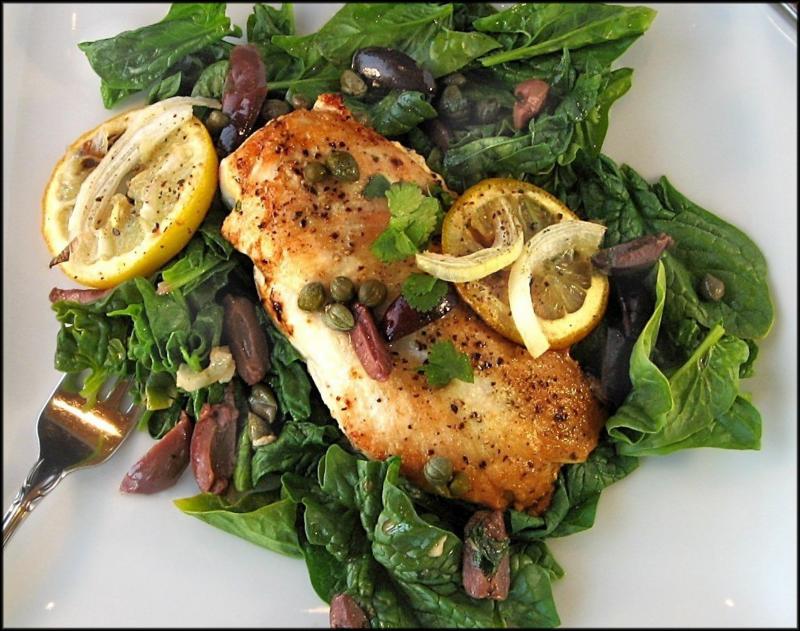Cooking with capers sounds like fun!
Of course you’ve seen them, sprinkled over nova lox on a bagel, stirred into pasta puttanesca sauce, mixed in caponata or tossed into lemony chicken piccata. What exactly are those sharp-flavored little green balls? Capers. From a culinary perspective (rather than high school hijinks), capers are the unripened flower buds of the perennial shrub Capparis spinosa.
This plant has been around for centuries, originating in the dry regions of Central Asia and widely cultivated throughout the coastal Mediterranean Sea basin. The name for the plant likely comes from the Greek kápparis, believed to be derived from their name for the island of Cyprus, where capers grow in abundance. The plant is so resilient it is seen thriving on bare rock, including the Wailing Wall in Jerusalem.
As with so many foods, who was the brave adventurer who thought it would be something good to eat? In the first century, Roman scholar Pliny the Elder advised using various parts of the caper plant as a remedy for toothache, rashes and to cure problems with the spleen.
Today, bringing capers from the plant to the table is not simple, which may explain their somewhat high cost for small quantities. First, capers must be harvested by hand, before the flower blossoms open in the morning. Once the unripened buds have been plucked from the plant, they are sorted by size and dried in the sun. And, in the same fashion as olives, capers are not delicious until they have been cured.
There are two approaches to curing capers – wet and dry. The first way is easier: Simply place the cleaned buds in a vinegar brine, allowing them to develop their signature sharp flavor. The alternative (and to many purists, preferable) technique is to combine the cleaned buds with coarse, granular salt to bring out their lemony bite. This is more labor-intensive to ensure the salt is evenly distributed, but the result is delicious.
When you’re shopping for jarred capers, you will see them in both preparations, brined and salted. You’ll also see them in various sizes. The smallest, typically less than a centimeter in diameter, are grown primarily in southern France and known as nonpareilles. In increasing size, capers are sorted into categories of surfines (the size of a small pea), capucines, capotes, fines and grusas.
Although the usual guidance directs shoppers to the smallest capers, they aren’t always the best choice, as the larger buds typically have a deeper flavor. They may be looser in texture, perhaps not as dense as the nonpareilles because the flower is more fully formed within the bud, which is much closer to opening.
Another tasty variation on the caper is what is known as a caper berry. These grow much like rose hips: After the flower has blossomed and the petals fall, a small, oblong fruit appears. About the size of an olive, the berry is attached to the plant by a long, cherry-like stem. When pickled, these make a terrific garnish for Bloody Mary cocktails.
Unopened jars of capers may be stored in the pantry for months. Once opened, store in the refrigerator and use within 90 days. Because of the large salt content in either wet or dry-cured capers, you should rinse and drain capers before adding them to the dish. For the best flavor, be sure to add capers at the end of the cooking process.
I’ve included recipes for the lemon caper chicken in the photo, a traditional eggplant caponata and an unusual onion preparation from Lidia Bastianich. Enjoy your capers!
Lemon Caper Chicken
1 sliced lemon
1 sliced onion
2 T olive oil
salt & pepper, to taste
4 skinless, boneless chicken breast halves
1 T flour
2/3 C chicken broth
1/4 C sliced pitted Kalamata olives
2 T drained capers
1 T chopped cilantro
Preheat the oven to 375 F. Line a baking sheet with aluminum foil and drizzle with 1 T olive oil. Arrange the lemon slices in a single layer, turning to coat both sides with oil. Scatter onion slices over lemons and sprinkle with salt and pepper. Bake until lemon edges are barely browned, about 25 minutes; remove pan from oven and set aside. Heat 1 T olive oil in a large, deep skillet. Season chicken on both sides with salt and pepper; dust with flour and shake off excess. Place chicken in pan and cook over medium heat until golden, turning once, about 5 minutes each side. Pour in the stock and scrape up any browned bits from the bottom of the pan. Stir in olives and bring to a boil; cook until liquid is reduced by half. Add capers, roasted lemons and onions; adjust seasonings and simmer until heated through. Serve on a bed of blanched spinach. Yield: 4 servings.
Caponata
2 eggplant
salt
1/4 C olive oil
1 chopped onion
2/3 C diced celery
2 minced garlic cloves
4 chopped Roma tomatoes
1/4 C red wine vinegar
1/4 C toasted pine nuts
1/4 C chopped Sicilian olives
1/4 C drained capers
pinch red pepper flakes (optional)
salt, to taste
Preheat the oven to 400 F. Peel eggplant and chop into 1-inch cubes. Line a baking sheet with parchment paper and arrange eggplant in a single layer. Sprinkle with salt and drizzle with 2 T olive oil. Bake until tender, about 25 minutes. Heat remaining 2 T olive oil in a skillet. Add onion, celery and garlic; cook over medium until onions are translucent, about 5 minutes. Add tomatoes and roasted eggplant; continue to cook until tomatoes are tender, about 10 minutes. Stir in vinegar, pine nuts, olives, capers and red pepper (if using); cook until heated through, about 3 minutes. Refrigerate overnight and bring to room temperature before serving with breadsticks.
Onions & Capers*
12 cippolini onions
12 whole cloves
4 T butter, cubed
2 C Marsala wine
2 C water
6 thyme sprigs
2 rosemary sprigs
6 peeled, crushed garlic cloves
1/2 t kosher salt
1/2 C drained capers
Peel onions, leaving them whole. Stick one clove into each onion. Place onions in a saucepan and add butter. Pour in wine and water; add thyme, rosemary and garlic. Bring to a boil, then reduce heat and cover; simmer for about 20 minutes.
Remove cover and add salt; simmer uncovered for another 15 minutes. Add capers and simmer another 5 minutes. Remove onions to a serving dish and reduce sauce until thickened into a glaze. Pour sauce over onions and serve as a side dish with roast chicken or beef. *Adapted from Lidia’s Commonsense Italian Cooking.
























































